Communist symbolism
This article needs additional citations for verification. (June 2008) |
| Part of a series on |
| Communism |
|---|
|
|
Communist symbolism represents a variety of themes, including revolution, the proletariat, peasantry, agriculture, or international solidarity.
Communist states, parties and movements use these symbols to advance and create solidarity within their cause. These symbols often appear in yellow on a red background. The flag of the Soviet Union incorporated a yellow-outlined red star and a yellow hammer and sickle on red. The flags of Transnistria, Vietnam, China, North Korea, Angola and Mozambique would all incorporate similar symbolism under communist rule.
The hammer and sickle have become the pan-communist symbol[citation needed], appearing on the flags of most communist parties around the world. Some parties have a modified version of the hammer and sickle as their symbol, most notably the Workers' Party of Korea which includes a hammer representing industrial workers, a hoe representing agricultural workers, and a brush (traditional writing-implement) representing the intelligentsia.
In Hungary,[1] Latvia, Indonesia, Poland, Ukraine and Lithuania, communist symbols are banned and displays in public for non-educational use are considered a criminal offense.[2]
Hammer and sickle[]

The hammer stands for the industrial working class and the sickle represents the agricultural workers, therefore together they represent the unity of the two groups.[citation needed]
The hammer and sickle were first used during the 1917 Russian Revolution, but it did not become the official symbol of the Russian Soviet Federative Socialist Republic until 1924.[citation needed] Since the Russian Revolution, the hammer and sickle have come to represent various communist parties and communist states.
Red star[]

The red five-pointed star is a symbol of the ultimate triumph of the ideas of communism on the five (inhabited, excluding Antarctica) continents of the globe. It first appeared as a military symbol in Tsarist Russia. It was then called the “Mars star,” reminiscent of Mars, the Ancient Roman god of war . On January 1, 1827, the law was signed that put a five-pointed star on the epaulets of officers and generals. In 1854, the star began to be used on shoulder straps. Later, the five-pointed star with a two-headed eagle inside it was used to mark military trains and carriages. In Soviet Russia, the five-pointed star symbolized the protection of peacetime labor by the Red Army (again, like in Ancient Rome, where Mars was also the protector of the agricultural workers). In 1918, the drawing of the badge for the soldiers of the Red Army in the form of a red star with a golden image of a plough and a hammer in the center was approved. The star symbolized protection, while the plough and the hammer were read as a union of workers and peasants. By the 1920s, the red star began to be used as an official symbol of the state, and finally in 1924, it became the part of the Soviet flag and the official emblem of the Soviet Union. [3][4]
In the succeeding years, the five-pointed red star came to be considered as a symbol of communism as well as broader socialism in general. It was widely used by anti-fascist resisting parties and underground socialist organizations in Europe leading up to and during World War II. During the war, the red star was prominently used as a symbol of the Red Army troops of the Soviet Union countering the invading forces of Nazi Germany and wiping them out of Eastern Europe, achieving absolute victory and ending the war at the Battle of Berlin.[citation needed] Most states in the Eastern Bloc incorporated the red star into state symbols to signify their socialist nature.
Red flag[]

The red flag is often seen in combination with other communist symbols and party names. The flag is used at various communist and socialist rallies like May Day. The flag, being a symbol of socialism itself, is also commonly associated with non-communist variants of socialism.
The red flag has had multiple meanings in history. It is associated with courage, sacrifice, blood and war in general, but it was first used as a flag of defiance.[5] The red flag gained its modern association with communism in the 1871 French Revolution.[citation needed] After the October Revolution, the Soviet government adopted the red flag with a superimposed hammer and sickle as its national flag. Since the October Revolution, various socialist states and movements have used the red flag.
Red and black flag[]

The red and black flag has been a symbol of general communist movements, though generally used by anarcho-communists. The flag was used as the symbol of the anarcho-syndicalists during the Spanish Civil War. The black represents anarchism and the red represents leftist and socialist ideals.[6] Over time, the flag spilled into statist leftist movements, these movements include the Sandinistas and the 26th of July Movement, where the flags colors are not divided diagonally, but horizontally. As in the case of the Sandinistas, they adopted the flag due to the movement's anarchist roots.[7]
Guerrillero Heroico[]
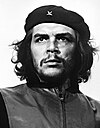
This famous photo captured by photographer Alberto Korda of Che Guevara in 1960 has become a world symbol of revolution. This image can be found on t-shirts, flags, hats, in street art, parodied in popular media, and even in the autonomous areas of Chiapas, Mexico, controlled by the EZLN.
The Internationale[]
The Internationale is an anthem of the Communist movement.[8] It is one of the most universally recognized songs in the world and has been translated into nearly every spoken language. Its original French refrain is C'est la lutte finale/Groupons-nous et demain/L'Internationale/Sera le genre humain (English: This is the final struggle/Let's group together and tomorrow/The International/Will be the human race). It is often sung with a raised fist salute.
The song has been used by communists all over the world since it was composed in the 19th century and adopted as the official anthem of the Second International. It later became the anthem of Soviet Russia in 1918 and of the Soviet Union in 1922. It was superseded as the Soviet Union anthem in 1944 with the adoption of the State Anthem of the Soviet Union, which placed more emphasis on patriotism. The song was also sung in defiance to Communist governments, such as in the German Democratic Republic in 1989 prior to reunification as well as in the People's Republic of China during the Tienanmen Square protests of the same year.[citation needed]
Plough (or Starry Plough)[]


Although not an exclusively communist symbol, the Plough, or Starry Plough, is a symbol of Irish socialism. It may have the same roots as the original hammer and Plough that was replaced by the hammer and sickle in Soviet Russia.[citation needed] The significance of the banner was that the free Workers of the Republic of Ireland would control its own destiny from the plough to the stars and the sword forged into the plough would mean the redundancy of war with the establishment of a socialist International. The flag depicts the Big Dipper, part of the constellation of Ursa Major that is known as "The Plough" in Ireland and Great Britain.[citation needed] The Plough is one of the most prominent features of the night sky over Ireland throughout the year. This was unveiled in 1914 and flown by the socialist workers' militia (the Irish Citizen Army) during the 1916 Easter Rising.
In China, the Plough flag (Chinese: 犁头旗), a red flag with white or yellow plough, is widely used in the period of the First Revolutionary Civil War as the flag of the Chinese peasant associations, an organization led by the Communist Party of China.[9][10] It is believed that Peng Pai (Chinese: 彭湃) was the first user in 1923 at the peasants' association of Hailufeng.[11] The Plough flag has many different versions and some are combined with the flag of Blue Sky, White Sun or Red Field;[12] other are different on the details of the plough.[13][14]
National emblems[]
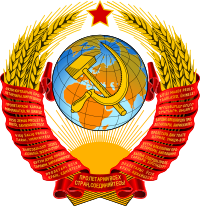
Many communist governments purposely diverged from the traditional forms of European heraldry in order to distance themselves from the monarchies that they usually replaced, with actual coats of arms being seen as symbols of the monarchs. Instead, they followed the pattern of the national emblems adopted in the late 1910s and early 1920s in Soviet Russia and the Soviet Union.[citation needed]
Other communist symbols[]
While not necessarily communist in nature, the following graphic elements are often incorporated into the flags, seals and propaganda of communist countries and movements.
- Revolutionary music as well as protest music. The Internationale falls under this category.
- Socialist realism, an art style developed in the Soviet Union.
- Crossed proletarian implements, including picks, hoes, scythes and in the case of the Workers' Party of Korea a brush to represent the intelligentsia. The ubiquitous hammer and sickle also belong in this category.
- Rising sun, exemplified on the state emblems of the Soviet Union, Turkmenistan, Croatia, Romania and PASOK.
- Cogwheels, exemplified on the emblems of Angola and China.
- Wreaths of wheat, cotton, corn or other crops, present on the emblems of almost every historical Communist-ruled state.
- Cherries resemblance from the Le Temps des cerises exemplified in the emblem of the Communist Party of Bohemia and Moravia.
- Rifle such as the AK-47 on the flag of Mozambique and Mosin–Nagant on Albanian lek.
- Red banners with yellow lettering, exemplified on the emblems of Vietnam and Soviet Union.
- Red or yellow stars, perhaps the most common communist symbol behind the hammer and sickle.
- Open books, exemplified on the state emblems of Mozambique, Angola and Afghanistan; and also on the party emblems of Communist parties of Russia and Ukraine.
- Factories or industrial equipment, exemplified on the emblems of North Korea, Bosnia and Herzegovina, Democratic Kampuchea, emblem of CPUSA and Azerbaijan.
- Natural landscapes, exemplified on the emblems of Armenia, Macedonia, Romania, and Karelo-Finland.
- Torches, exemplified on the Emblem of Yugoslavia.
- Sword and shield, exemplified on the Soviet Committee for State Security emblem and the Mother Motherland.
- Cross and sickle, the symbols of the Christian communism and Christian socialism
- Portraits of various communist leaders, such as Vladimir Lenin, Joseph Stalin, Mao Zedong, Josip Broz Tito, etc.
- Che Guevara's image, in particular as it appears in Guerrillero Heroico (“Heroic Guerilla”), is a common symbol of the Cuban Revolution,[15]:19 Guevarism, and revolution in general.[15]:73[16]
- The Arm and hammer, exemplified in the logo of the Socialist Labor Party of America
Notable examples of communist states that use no overtly communist imagery on their flags, emblems or other graphic representations are Cuba and the former Polish People's Republic.
Gallery[]
Examples of these symbols in use.
Hammer and sickle[]

Flag of the Communist Party of China

Flag of the Chinese Workers' and Peasants' Red Army

Flag of the Soviet Union
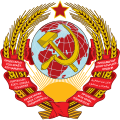
First State Emblem of the Soviet Union (1923-1936)

Emblem of the Uzbek Soviet Socialist Republic

Flag of the Workers' Party of Korea with hammer, sickle, and paintbrush.

State emblem of Lao People's Democratic Republic (1975-1991)

Symbol of the Fourth International

Flag of the Revolutionary People's Liberation Party/Front (Turkey)

Symbol of the Mexican Communist Party
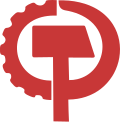
Symbol of the Communist Party USA

The cross and sickle, symbol of Christian communism and Christian socialism

Hammer and sickle, symbol of Communist Party of India (Marxist)

Flag of the Communist Party of Bangladesh
Red star[]

Flag of People's Republic of Benin (1975-1990)
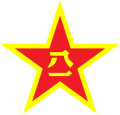
Emblem of the Chinese People's Liberation Army

Flag of North Korea

Coat of arms of Hungarian People's Republic (1957-1990)

Emblem of the Transcaucasian SFSR (1930-1936)
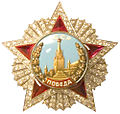
Soviet Order of Victory Award (1945)

Logo of the United Socialist Party of Venezuela

Flag of South Yemen

Coat of Arms of South Yemen (1970-1990)

Flag of Socialist Federal Republic of Yugoslavia (1945–1992)

Emblem of SFR Yugoslavia (1945–1992)

Logo of the Red Army Faction (West Germany)

Flag of the EZLN and the Neozapatista ideology

Flag of the Popular Front

Flag of the Kurdistan Workers' Party

Flag of the Youth International Party
Red and black flag[]

Flag of the Confederación Nacional del Trabajo (Spain)

Flag of the Sandinistas (Nicaragua)

Flag of the 26th of July Movement (Cuba)

Flag of the National Liberation Army (Colombia)

Flag of the Rebel Armed Forces (Guatemala)

Flag of the Revolutionary Movement 13th November (Guatemala)

Flag of the Partido por la Victoria del Pueblo (Uruguay)

Flag of the Revolutionary Left Movement (Chile)

Flag of the People's Movement for the Liberation of Angola

Flag of the Awami Tahreek (Pakistan)

Flag of the Botswana Democratic Party

Flag of the Revolutionary Movement Tupamaro (Venezuela)

Flag of the Intransigent Party (Argentina)

The logo for Antifa

The flag of Angola
Plough[]
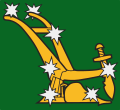
The Starry Plough flag used by the Irish Citizen Army

A modern variant of the Starry Plough

Flag of the Chinese Peasants' Association

Another version of the flag

Flag of the Guangdong Peasants' Association during the period of the First United Front
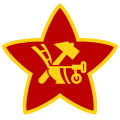
Star, hammer and plough cockade of the Red Army.
Other symbols[]

The flag of Vietnam, an example of a red flag with a gold star.

Flag of the People's Republic of China.

Young Pioneers pin featuring a stylized portrait of Vladimir Lenin

Statue of Vladimir Lenin

Stalin stamp from German Democratic Republic. Stalin's image was commonly used by Marxist–Leninist states and movements

Quotations from Chairman Mao Tse-tung (aka the "Little Red Book), associated with Maoism

Flag featuring the "Three Heads" of Karl Marx, Friedrich Engels, and Vladimir Lenin

The "Four Heads" of Marxism: Marx, Engels, Lenin, and Stalin

The "Five Heads" of Marx, Engels, Lenin, Stalin and Mao

Che Guevara's image, symbol of Guevarism

A revolutionary worker in socialist realist style

Stylized raised fist, used both as a symbol in itself and as a salute.

The portraits of Karl Marx, Emiliano Zapata, and Subcomandante Marcos, all symbols used in the Neozapatismo ideology.

Badge of the Democratic Army of Greece, with a stylized D (Δ)
See also[]

- Anarchist symbolism
- Bans on Communist symbols
- Communist chic
- Hammer and sickle (☭)
- The Internationale
- Raised fist
- Red flag (politics) (
































































